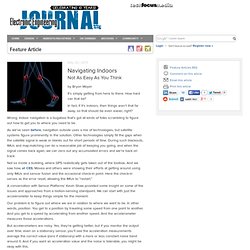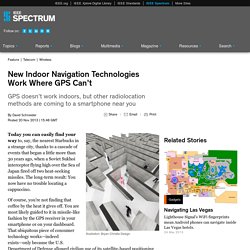

Navigating Indoors. May 20, 2013 by Bryon Moyer It’s simply getting from here to there.

How hard can that be? In fact, if it’s indoors, then things aren’t that far away, so that should be even easier, right? Wrong. As we’ve seen before, navigation outside uses a mix of technologies, but satellite systems figure prominently in the solution. Not so inside a building, where GPS realistically gets taken out of the toolbox. A conversation with Sensor Platforms’ Kevin Shaw provided some insight on some of the issues and approaches from a motion-sensing standpoint. Our problem is to figure out where we are in relation to where we want to be. But accelerometers are noisy. To get speed, you need to integrate the acceleration over time. To get position, you need to integrate the speed over time. This means that dead reckoning has a sell-by date: your errors can accumulate in minutes, even seconds.
All of the above error discussion assumes you know your orientation exactly. The key here is on narrowing the error band. New Indoor Navigation Technologies Work Where GPS Can’t. Today you can easily find your way to, say, the nearest Starbucks in a strange city, thanks to a cascade of events that began a little more than 30 years ago, when a Soviet Sukhoi interceptor flying high over the Sea of Japan fired off two heat-seeking missiles.

The long-term result: You now have no trouble locating a cappuccino. Of course, you’re not finding that coffee by the heat it gives off. You are most likely guided to it in missile-like fashion by the GPS receiver in your smartphone or on your dashboard. That ubiquitous piece of consumer technology works—indeed exists—only because the U.S. Department of Defense allowed civilian use of its satellite-based positioning system. The Department of Defense dutifully carried out Reagan’s instructions to make GPS signals available for civilian uses, but it hedged at first, adding random timing errors to the satellite signals accessible to nonmilitary GPS units so they could determine locations to no better than 100 meters. SmartIndoor. Drive Store Visits, Loyalty & Basket Size. Scalable Platform aisle411 scales fast.

Our proprietary technology and team has scaled thousands of retail stores with the aisle411 platform in weeks, and currently powers over 12,000 locations with the ability to handle frequent updates and resets to inventory and floor map layouts. Offer Location Optimization aisle411’s unique offer placement logic optimizes all your digital offers so they’re enhanced with in-store location. This means shoppers can locate offers in-aisle and promotional messaging can be triggered based on shopper location. Shopper Location aisle411’s patent pending indoor location platform is designed to work with multiple technologies. Data Layering aisle411 turns your enterprise space planning, inventory and planogram data assets into useful searchable information to shoppers. aisle411’s unique data architecture, categorization systems and search taxonomy tagged to each item allows shoppers to get great search results designed to get products in shoppers hands.
Google’s Road Map to Global Domination. Indoor positioning: Finding the way inside. Ten Things You Need to Know About Indoor Positioning. Summary: Each year indoor positioning has created more buzz in the location-based services arena.

Acquisitions and new developments suggest 2013 might be a breakthrough year for the technology. Executive Editor Adena Schutzberg shares the basics on how it works and where it might be headed. 1. GPS does not work well indoors While today’s more sensitive GPS chips can sometimes get a fix (receive signals from enough satellites to determine a location) inside a building, the resulting location is typically not accurate enough to be useful. 2.
Locata, an Australian company, offers beacons that send out signals that cover large areas and can penetrate walls. 3. ByteLight sends flickering light patterns from its LED light fixtures. 4. Passive radio frequency identification tags (RFIDs) prompt a transaction when they pass near a sensor. 5. While indoor positioning systems can determine location, many need additional information to determine which way a person or object is facing. Locate, Map, Track. Indoors. TRX Systems.